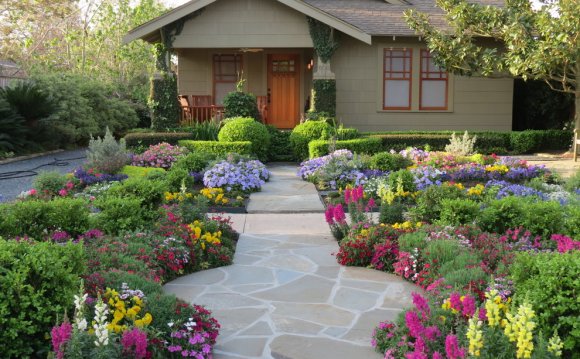
 With clever planting, a small front garden can shine [GETTY]
With clever planting, a small front garden can shine [GETTY]
Don’t feel there’s nothing you can do with a postage stamp-sized plot. Even when it also has to double as a parking space, it is possible to create a dual-purpose designer look that makes the most of this seemingly impossible situation – I’ve seen it done many times.
Planning
Start designing indoors – winter is the ideal time. Make a plan of the area on squared paper and draw it to scale; one inch to a foot is ideal. If you need parking space for a car, caravan or bins, mark these in, again drawn to scale, allowing realistic access to the road and for opening the doors.
Now see what space is left for beds or containers. Try out several alternative schemes on paper and decide which you like best.
Cars and caravans
Avoid the temptation to concrete the area over entirely. Unless a car or caravan is left parked for long periods of time, creating deep shade underneath, you can usually get away with laying slabs or gravel only where the wheel tracks will go (they’ll need a layer of hardcore and concrete underneath to support the weight without sinking).
Winter sweet is one of the best shrubs in flower in this time of the year [GETTY]
The remaining ground can be used for low ground-cover plants: choose shade-tolerant species such as ajuga, ivies and lamium. If the parking space is left empty every day when you go to work, leaving a sunny open space, go for short spreading sun lovers like chamomile, creeping thymes and golden marjoram.
Fragrant plants such as these will add so much to your front garden, and the scent will follow you indoors.
The green, green grass
Don’t try to squeeze a lawn into a tiny area – it’ll be a nuisance to mow, and if there’s no side access gate you’ll have to carry your mower through the house.
Gravel or paving makes a simpler alternative. No foundations are needed when the area won’t carry any weight, so you can lay them straight on to firmed and levelled soil. If the area will be used for standing bins, screen off a corner using bamboo or heather panels to conceal them.
If you prefer the look of grass, a very small space is an ideal place to use artificial lawn, which looks very realistic but is totally maintenance-free once you’ve put down the special foundation layer.
There are plenty of suppliers online, and the cost won’t be excessive for a small area.
Related articles
What to plant?
Avoid putting in potentially large, fast-growing or invasive plants, or any that generate lots of mess or prunings. Also avoid a dense planting scheme that will obscure your windows, making your front rooms dark and dingy.
Hedges take a lot of upkeep and can look too chunky in a small space, so opt for a long, narrow bed instead. Choose tallish, airy plants to create a semi-see-through screen – the idea is to give yourself some privacy while still being able to see out.
For year-round interest, try mixtures of Thalictum “Hewitt’s Double”, Salvia uliginosa, Verbena bonariensis and tall evergreen grasses.
Pots and tubs
Small tubs are an easy target for thieves, besides needing frequent watering and re-planting. Instead, use large tubs planted with year-round plants and let them root through into the ground so they can’t be moved.
For year-round looks, grow architectural shrubs such as bamboo, Fatsia japonica, phormium, box topiary or a standard-trained bay tree. Keep them well watered to encourage roots to reach down deep, and once established, the plants will rarely need watering.
The plant of the week: Winter sweet
There aren’t many shrubs in flower now, but winter sweet (Chimonanthus praecox) is one of the best. An uncommon deciduous shrub that flowers from December to March, it has pale yellow flowers with a rich, spicy scent.
It’s happy in any reasonable garden soil but it prefers a sunny situation – and since it can reach eight feet in each direction, the best way to grow it in a small garden is trained flat against a wall.
What to do this week
- When forced hyacinths are past their best, plant them out in the garden.
- If you want to keep your pot-grown Christmas tree for next year, stand it outside in a sheltered spot. Keep it watered and repot it next April.















